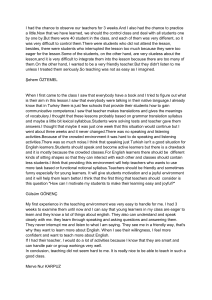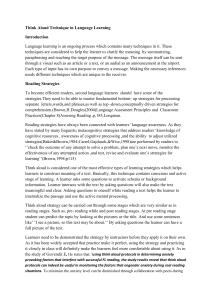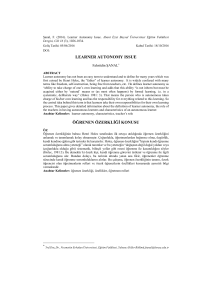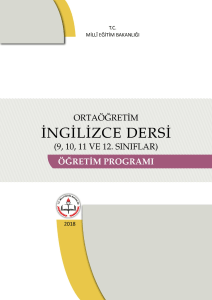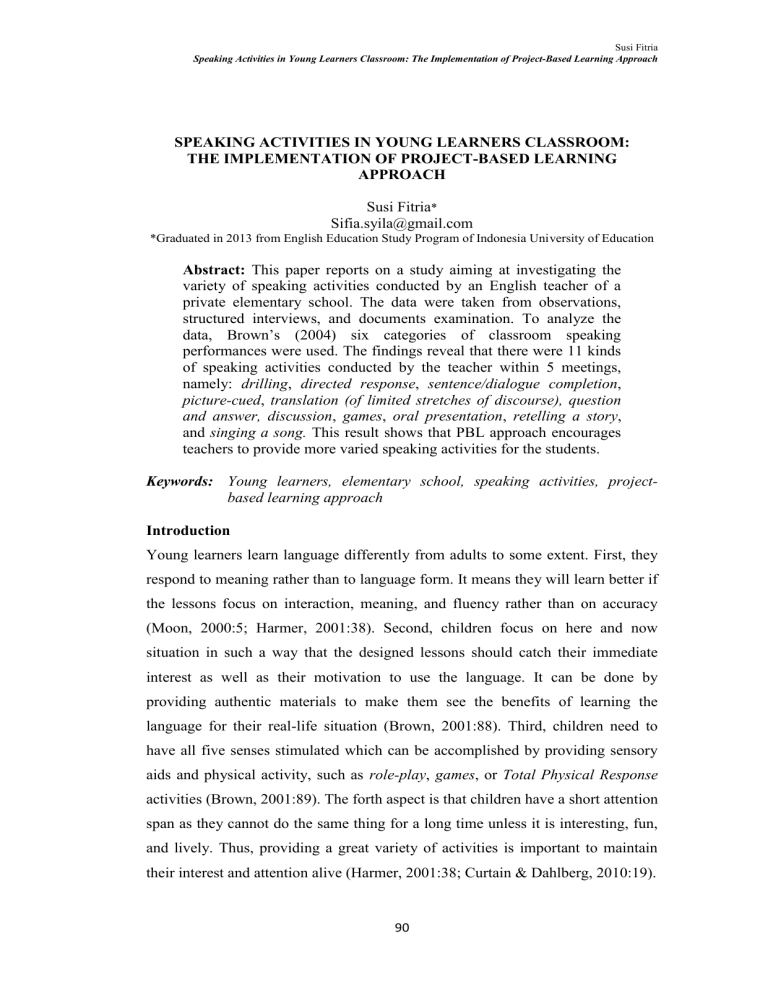
Susi Fitria Speaking Activities in Young Learners Classroom: The Implementation of Project-Based Learning Approach SPEAKING ACTIVITIES IN YOUNG LEARNERS CLASSROOM: THE IMPLEMENTATION OF PROJECT-BASED LEARNING APPROACH Susi Fitria* Sifia.syila@gmail.com *Graduated in 2013 from English Education Study Program of Indonesia University of Education Abstract: This paper reports on a study aiming at investigating the variety of speaking activities conducted by an English teacher of a private elementary school. The data were taken from observations, structured interviews, and documents examination. To analyze the data, Brown’s (2004) six categories of classroom speaking performances were used. The findings reveal that there were 11 kinds of speaking activities conducted by the teacher within 5 meetings, namely: drilling, directed response, sentence/dialogue completion, picture-cued, translation (of limited stretches of discourse), question and answer, discussion, games, oral presentation, retelling a story, and singing a song. This result shows that PBL approach encourages teachers to provide more varied speaking activities for the students. Keywords: Young learners, elementary school, speaking activities, projectbased learning approach Introduction Young learners learn language differently from adults to some extent. First, they respond to meaning rather than to language form. It means they will learn better if the lessons focus on interaction, meaning, and fluency rather than on accuracy (Moon, 2000:5; Harmer, 2001:38). Second, children focus on here and now situation in such a way that the designed lessons should catch their immediate interest as well as their motivation to use the language. It can be done by providing authentic materials to make them see the benefits of learning the language for their real-life situation (Brown, 2001:88). Third, children need to have all five senses stimulated which can be accomplished by providing sensory aids and physical activity, such as role-play, games, or Total Physical Response activities (Brown, 2001:89). The forth aspect is that children have a short attention span as they cannot do the same thing for a long time unless it is interesting, fun, and lively. Thus, providing a great variety of activities is important to maintain their interest and attention alive (Harmer, 2001:38; Curtain & Dahlberg, 2010:19). 90 Journal of English and Education 2013, 1(2), 90-102 On the other hand, English teaching practice in many EFL classrooms, including in Indonesia, does not involve adequate variant of activities, especially speaking activities. It merely focuses on drilling grammar knowledge and reading comprehension rather than encourages students’ interaction and communication (Howard and Millar, 2009). In case if teachers provide students speaking activities, the students do not respond or are not willing to participate actively since there are not enough support for them to speak (Damayanti, 2010). In fact, Harmer (2001) states that students’ courage and willingness to communicate is very crucial. By having courage to participate in speaking activities, students will have the opportunity to rehearse real-life speaking in safety-classroom situation. Besides, successful second or foreign language learning is extremely affected by social experience: the quantity and quality of input and interaction. So, it is very suggested for students to get extensive target language (L2) input as well as the opportunity for output in the form of interaction using the L2 (Saville-Troike, 2006; Ellis’s, 2005) Concerning the issue, designing appropriate lessons for children as young language learners which provide many opportunities for them to speak English is needed. In this case, there is an approach called “Project-Based Learning” (PBL) which is relevant to the need. Literature Review Grant, (2002:1) saw PBL as “…an instructional method centered on the learner.” This approach organizes learning around projects which are realized in the form of complex tasks. While making the project, students can develop their problem-solving, decision-making, and investigation skills. They also have the opportunity to work autonomously over a given period of time to create realistic products in a variety of presentation form. The products are personally meaningful and become the representation of what they have learnt (Thomas, 2000; Klein et al., 2007). Some studies showed that PBL enhanced the students’ intrinsic motivation and self-esteem. It also enhances the integration of the four language skills as the 91 Susi Fitria Speaking Activities in Young Learners Classroom: The Implementation of Project-Based Learning Approach students processed information from a various resources while doing the project (see also Blumenfeld, 1991; Gaer, 1998; Fragoulis, 2009; Bell, 2010; Poonpon, 2011). In this study, the aim was to investigate on the variety of speaking activities conducted by an English teacher of a private elementary school which attempts to implement PBL in teaching speaking to the students. This study used Brown’s (2001) six distinctive categories of classroom speaking performances as the framework of analysis. The following explanation elaborates on each kind of them. Imitative The focuses of this category is pure in phonetic level of oral production. It has nothing to do with students’ comprehension (Brown, 2004). The only role of the students is to repeat what they listen from a human tape recorder, like practice an intonation contour or pronounce a certain vowel sound correctly. The activity is called drilling. Intensive This category leads the students to produce the language by themselves. The language production is in the form of responding to teachers’ question or interacting with others at minimal length of utterance. This technique focuses on a small range of grammatical, phrasal, lexical, or phonological competences. Here, the teacher controls the answers so the answers are fixed. This technique is realized in (1) Directed Response, (2) Read-Aloud, (3) Sentence/Dialogue Completion, (4) Oral Questionnaire, (5) Picture-Cued, and (6) Translation (of limited stretches of discourse) (Brown, 2004). Responsive This technique requires students to respond to teacher or other students’ questions. The respond is usually short, meaningful, and authentic—not in the form of dialogue. This time, students’ comprehension is taken into account and 92 Journal of English and Education 2013, 1(2), 90-102 the stimulus is delivered orally by the teacher to maintain the authenticity of students’ answers. The activities are: (1) Question and Answer, (2) Giving Instruction and Directions, and (3) Paraphrasing (Brown, 2004). Interactive: Transactional (dialogue) This is longer and more complex form of responsive technique. The purpose of this technique is to accustom students to be able to convey or exchange fact, information, or opinion with others. The following activities are the examples of this technique: (1) Interview, (2) Discussion, and (3) Games (Brown, 2004). Interactive: Interpersonal (dialogue) The purpose of this technique is for maintaining social relationships. Casual register, ellipsis, sarcasm, slangs, humor and other sociolinguistics dimensions are features that must be known by students in this technique. The examples of the specific activities are: (1) Conversation and (2) Role Play (Brown, 2004). Extensive (monologue) In this technique, the language production is frequently planned and the participants’ role is as listeners. They might respond to the speech, but it is limited to nonverbal responses. The activities can be realized in form of: (1) Oral Presentation, (2) Picture Cued Storytelling, (3) Retelling A Story, (4) News Event, and (5) Translation (of extended prose) (Brown, 2004). Methodology A case study approach was chosen in this research regarding to the aim which attempts to “investigate processes, and to gain insight into an in-depth understanding of an individual, group, or situation” (Lodico, et al.’s, 2006: 269). The participants in this study were a male English teacher of one private elementary school in Bandung and 30 third grade students of that school. In collecting the data, this study used three instruments, namely: (1) interviews; (2) observations; and (3) documents analysis. 93 Susi Fitria Speaking Activities in Young Learners Classroom: The Implementation of Project-Based Learning Approach To answer the research question, non-participant observations were used five times as the project was lasted for 5 weeks. The title of the project was “Indonesian Traditional Clothes Fashion Show” in which the students were expected to make a scrapbook presenting about Indonesian traditional clothes at the end of the project. While doing the observations, the writer used observation checklist which was based on theories from Brown (2001a, 2004b) related to classroom speaking performance. Structured interview was employed to the English teacher to find out his reason for implementing the approach, the purposes in conducting the activities and the difficulties he had while implementing the approach and conducting the activities. Finally, the teachers’ lesson plans during the five weeks of observations served as the basis for the documents analysis in this study. Data Presentation and Discussion The observation result reveals that the teacher applied 5 among 6 categories of classroom speaking performance proposed by Brown (2004) during 5 weeks of observations. There were 10 kinds of speaking activities from those categories conducted in the classroom. Here is the detail. (1) Imitative: drilling and singing a song; (2) Intensive: directed response, sentence/dialogue completion, picturecued, and translation (of limited stretches of discourse); (3) Responsive: question and answer, (4) Interactive (transactional): discussion and games; and (5) Extensive (monologue): oral presentation. The teacher also conducted another speaking activity beside those proposed by Brown (2004), namely singing a song. The following table reveals the detail of speaking activities conducted by the teacher in each meeting. 94 Journal of English and Education 2013, 1(2), 90-102 Drilling The teacher conducted drilling in four meetings. It was done to help the students to memorize the material about Indonesian Traditional Clothes which became their project. By drilling, the teacher hoped that the students would understand certain language elements subconsciously in long-term memory. Sometimes the teacher did the drilling by sang it. He believed that song, along with games and other activities, helps students to be comfortable with their learning. Besides, it accommodates children’s multiple intelligence, especially musical intelligence (Gardner, 1983, as cited in Curtain & Dahlberg, 2010). In addition, Linse (2005:59) suggests that teacher can select the songs which focus on specific phonemes or sounds in teaching pronunciation as children may have trouble in pronouncing particular English sounds. This finding is relevant to Freeman’s statement (1986) that language learning is a process of habit formation. Here, the teacher did lots of repetition to strengthen the habit and the learning. The process started with practicing and drilling some phrases and repeating models to accustom their tongue with L2 and to relate grammatical forms with their context. In addition, drilling also gives the opportunity for students to practice a series of languages that may be difficult for them from which teacher can find the difficulty and decide which part needs emphasize more (Brown, 2001; Pinter, 2006). Directed Response The result indicates that the teacher used directed response in four meetings to evaluate the students’ linguistics competences as well as to trace their language deficiency. The language produced by the students in this study was in the form of responding to the teachers’ instructions at minimal length. Here, the students were required to process a little meaning to produce the languages which are grammatically appropriate. In this case, students’ grammatical errors only serve as the indicator of students’ difficulty from which later the teacher can give 95 Susi Fitria Speaking Activities in Young Learners Classroom: The Implementation of Project-Based Learning Approach reinforcement. This finding is consistent with Brown’s (2004:147) idea that directed response leads teacher to elicit certain grammatical aspects. Sentence/Dialogue Completion The finding presents that teacher only used this activity once while the students were discussing their homework. The purpose of this activity was to introduce the written form of the language, and to give guidelines for the students to talk. The result is irrelevant with Brown’s (2004) idea which states that sentence completion functions to give students more time to think the answers. Yet, the second purpose is relevant to Harmer’s (2001). He stated that a guideline is useful to maintain students’ feeling of security and confidence. It tells students what to talk in the communication process. Some key languages, such as phrases or questions will be very helpful for students to ease their frustration in not knowing how to express their ideas. Picture-Cued Picture-cued was used in four meetings by the teacher. The purposes were to check students’ prior knowledge, accommodate students’ multiple intelligences, and give the concrete visualization of what being learnt to children since children cannot learn abstract concept. This finding is in line with Brown’s (2004) statement that picture-cued activity is one of the most popular ways to elicit oral language performance. In this sense, responding to picture prompt is appropriate for children at this age i.e. 8 to 10 years or grades 3, 4, 5 (Curtain & Dahlberg, 2010). Translation (of limited stretches of discourse) The teacher conducted this activity once while teaching new vocabulary. It was done when eliciting the vocabulary using pictures was unsuccessful. From the interview, it is known that the teacher believed Freeman’s (1986) idea which states that translation is ineffective since children are indeed focus on meaning already. In learning a foreign language, the L1 and L2 have different linguistics system. They should be kept apart to prevent the interference of the L1 to the L2. 96 Journal of English and Education 2013, 1(2), 90-102 Question and Answer Question and answer was conducted in the entire meetings. The teacher did this activity in greeting the students, reviewing previous lessons, telling stories, discussing group result, and attracting students’ attention. This result is in line with Brown’s (2004) statement that question and answer allows students to interact with others more creatively as they produce meaningful language in response. The feature also makes it appropriate for young learners as they focus predominantly on meaning (Moon, 2000). Discussion Discussion was conducted by the teacher two times to let the students interact with their peers in their own language. Through the discussions, they could practice their talk without any worries of adults’ interference. The discussions that were conducted by the teacher are what Harmer (2001) calls “buzz group” in which the students were given time to discuss before they talk in front of the class. Discussions, along with games and role-plays, can maximize the amount of communicative and interactional practice between students. It can also motivate them to learn as they have the opportunity to express their ideas and opinion (Freeman, 1986; Scott & Ytreberg’s, 1990; Curtain & Dahlberg, 2010). Games Teacher conducted games once to increase students’ mood and to provide some spaces for the students to move. This finding is relevant to Curtain & Dahlberg’s (2010) statement which maintains that game, and other activities that involve movements have positive emotion associated with them. If the activity is associated to positive emotions, there will be a “brain-patterning” which reinforce any language elements that teachers deliver (Caine, 1997, as cited in Curtain & Dahlberg, 2010). Oral Presentation Oral Presentation was done when the students were presenting about the project. The teacher claimed that oral presentation was the core of PBL, 97 Susi Fitria Speaking Activities in Young Learners Classroom: The Implementation of Project-Based Learning Approach especially when it was speaking class. Oral presentation gives students the opportunity to talk or communicate with others by using their own language. In this study, it also served as the indicator of what they had learnt during the implementation of the project. This result is consistent with Thomas (2000) and Klein et al. (2007) who argue that PBL is very identical with oral presentation as the purpose is to develop students’ communication skill. In this study, the project was presented by the students at the end of the learning period through which their level of understanding toward the subject being learned was measured. Retelling A Story Retelling a story was conducted by the teacher once. He conducted this activity to train students’ pronunciation as well as students’ vocabulary mastery. Stories are very appropriate media to teach vocabulary and pronunciation to children (Cameron, 2001). Compared to paraphrasing, one benefit of this activity is that it involves students’ emotion which is proven can promote learning (Curtain & Dahlberg, 2010). When students enjoy the stories, they will understand the material easily (Wright, 2001) (see again the theory of “brain-patterning”). Besides, retelling a story also develops students’ creative thinking and helps students to express their ideas since stories provide a rich experience of language (Kayi, 2006). Conclusions It has shown that PBL approach has rich speaking activities in the classroom. Unlike the communicative approach which focuses on interactive category of classroom speaking performances only, such as language games and role play (Freeman, 1986), PBL approach allows more categories of classroom speaking performance suggested by Brown (2004) to take place. Nevertheless, a number of important limitations need to be considered. First, with a small site range, caution must be applied, as the findings might not be transferable to all grade of elementary school. Second, the writer only did the observation for 5 weeks or in one period of the project making meaning that there 98 Journal of English and Education 2013, 1(2), 90-102 might be more various activities conducted by the teacher in case if the students make other projects. The writer suggested further study to conduct similar research involving more participants in higher or lower grade as well as investigating the overall classroom interaction during each activity to gain more rigorous detail of students’ oral performance. Additionally, the research may be undertaken to investigate the media or learning aids used by teacher as well as the assessment process. As for teachers, it is needed to be realized that not all students have the expected linguistic competence or the same prior knowledge. Therefore, knowing students’ language capacity is very important before designing the activities or choosing the content for the learning. References Bell, S. (2010). “Project-Based Learning for the 21st Century: Skills for the Future”. Routledge: Taylor& Francis Group 83, (2), 39-43. Brown, H.D. (2001). Teaching by Principles: An Interactive Approach to Language Pedagogy. Singapore: Longman. Brown, H.D. (2004) Language Assessment: Principles and Classroom Practices. New York: Pearson Longman. Cameron, L. (2001). Teaching Languages to Young Learners. Cambridge: Cambridge University Press. Cohen, L, et al. (2005). Research Method in Education 5th Edition. New York: Taylor & Francis e-library. Creswell, J. W. (2008). Educational Research. New Jersey: Pearson Education. Curtain, H., & Dahlberg, C.A. (2010). Language and Children: Making The Match, New Languages Fro Young Learners, Grade K-8,4/E. (kota): Allyn & Bacon. Damayanti, et al. (2010). The Relevance of English For Young Learners Course to The Needs of English Language Learning In Primary School. Retrieved October 21, 2012 from http://didisukyadi.staf.upi.edu/files/2011/04/IkaLestari-Damayanti.pdf. 99 Susi Fitria Speaking Activities in Young Learners Classroom: The Implementation of Project-Based Learning Approach Damayanti, I. L. (2010). A Child-Friendly Way to Teaching Young Learners: The Implementation of M-U-F Framework. Retrieved October 21, 2012 from http://didisukyadi.staf.upi.edu/files/2011/04/Ika-Lestari-Damayanti.pdf. Depdiknas (2003). Kurilulum 2004. Standar Kompetensi. Mata pelajaran Bahasa Inggris. Sekolah Dasar dan Madrasah Ibtidaiyah. Jakarta: Depdiknas. Dornyei, Z. (2005). The Psychology of The Language Learner: Individual Differences in Second Language Acquisition. New Jersey: Lawrence Erlbaum Associates, Inc., Publishers. Ellis, R. (2005). “Principles of Instructed Language Learning”. Asian EFL Journal. Emilia, Emi. (2001). A Critical Genre-Based Approach to Teaching Academic Writing in a Tertiary EFL Context in Indonesia. Thesis Master in Department of Language, Literacy and Arts Education Faculty of Education The University of Melbourne: Unpublished. Fragoulis, I. (2009). “Project-Based Learning in the Teaching of English as A Foreign Language in Greek Primary Schools: From Theory to Practice”. English Language Teaching. 2, (3), 113-119. Gaer, S. (1998). “Less Teaching and More Learning”. Focus on Basics: connecting research & practice (2), 1-7. Gorgon & Matera (2008). Advantages and Disadvantages of Pair Work and Group Work. [Online]. Available: http://portal.gim-nt.com [November, 10th 2012] Grant, M. M. (2002). “Getting A Grip On Project-Based Learning: Theory, Cases And Recommendations”. Meridian: A Middle School Computer Technologies Journal. 5, (1), 1-3. Harmer, J. (1998). How to Teach English. Malaysia: Longman. Harmer, J. (2001). The Practice of English Language Teaching (third ed.). New York: Longman. Hatch, J, M. (2002). Doing Qualitative Research in Education Settings. Albany: State University of New York Press. Higa, H. (2002). “Lesson Ideas for Children: Drilling Masked as Fun and Games”. Paper in Conference Proceedings JALT2002, Shizuoka. 100 Journal of English and Education 2013, 1(2), 90-102 Howard, J. & Millar, S. (2009). “The Applicability of Principles for Instructed Second Language Learning: A South Korean Perspective”. Asian EFL Journal. 4, (2), 1-14. Katzoff, S. (1964). Clarity in Technical Reporting. Washington, D.C: NASA (National Aeronautics and Space Administration). Kayi, H. (2006). “Teaching Speaking: Activities to Promote Speaking in a Second Language”. The Internet TESL Journal. 11, (12), -. Klein, J. I. et al. (2009). Project-Based Learning: Inspiring Middle School Students To Engage In Deep And Active Learning. New York: NYC Department of Education. Lauder, A. (2008). “The Status and Function of English In Indonesia: A Review of Key Factors”. Makara, Social Humaniora. 12, (1), 9-20. Linse, C. T. (2005). Practical English Language Teaching: Young Learners. New York: McGraw-Hill. Lodico, M.G., et al. (2006). Methods in Educational Research: From Theory to Practice. USA: Jossey-Bass A Wiley Imprint. Moon, J. (2000). Children Learning English. Oxford: Macmillan Heinemann. Nunan, D. (2000). Language Teaching Methodology (third ed.). Malaysia: Longman. Pinter, A. (1999). Teaching Young Language Learners. New York: Oxford University Press. Poonpon, K. (2009). “Enhancing English Skills Through Project-Based Learning”. The English Teacher. XL, 1-10. Saville-Troike, M. S. (2006). Introducing Second Language Acquisition. New York: Cambridge University Press. Scott, W. A & Ytreberg, L. H. (1990). Teaching English to Children. New York: Longman. Suyanto, Kasihani K.E. (2007). English for Young Learners. Jakarta: Bumi Aksara. Terry, C. (2008). “How to Teach Speaking in EFL Class”. A paper on ICPNA, San Miguel. 101 Susi Fitria Speaking Activities in Young Learners Classroom: The Implementation of Project-Based Learning Approach Thomas, J.W. (2000). A Review Of Research On Project-Based Learning. [Online]. Available: http://www.bie.org/index.php/site/RE/pbl_research/29 [March, 26th 2012] 102
